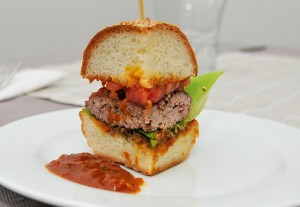Why Puree?
by Karen Sheffler, MS, CCC-SLP, BCS-S of SwallowStudy.com
Think summertime! Time for BBQ, juicy watermelon, chips & salsa, and more!
Imagine all the different textures in your favorite thick cheeseburger.

Background on Puree:
Think about all the skills, strength and timing we need to eat these regular foods. Many people cannot manage such a challenging variety of textures. A Speech-Language Pathologist, who specializes in dysphagia (difficulty swallowing), can evaluate your safety with the following swallowing basics for solid foods. Go ahead and answer these questions for yourself to get an idea if you need to be evaluated further.
Mouth skills:
- Can you open your mouth wide?
- Can you bite down into a thick, hard, rubbery, and/or tough food?
- Can you move that bite of food around your mouth, specifically to your back teeth for chewing?
- Can you grind up your food with your teeth? (Back teeth are helpful to grind in a circular motion (called rotary chewing), but I have seen people function quite well with a tough set of gums.)
- Can you sweep your tongue around your teeth to clear the food that falls into your cheeks?
- Can you control that food and form it into a ball? (This would mean that the food does not excessively fall into your cheeks, out of your mouth or into your throat before you are ready to swallow it. Note: it is normal for some food to drop back to the pockets in the throat, prior to the swallow while you are chewing.)
- Can you control the liquid in that ball of food, while you are chewing the solid? (Foods that are juicy, like watermelon, have a lot of liquid that squeezes out when you are chewing. Soup, cold cereal, and fruit cocktail will have liquids and solids in one spoonful.)
- Can you use the top of your tongue to strip the food off the roof of your mouth?
- Can you move that ball of food to the back of your mouth with control?
That is the end of the “skill” area, where you can have total control over the food.
Throat:
- Does your swallow trigger right away when you push that ball of food back into your throat?
- When you swallow, does the food easily clear through your throat with 1-2 swallows without getting stuck or making you cough or choke?
Food tube (esophagus):
- Does the food empty through your food tube into your stomach without getting stuck or coming back up on you?
If you answered “NO” to any of the questions above, you may have difficulty managing and swallowing foods (also called: solid dysphagia or dysphagia to solids). Describe these symptoms to your doctor to get a referral to a Speech-Language Pathologist who specializes in swallowing.
Read more: How is my swallow evaluated?
Why should I worry about solid dysphagia?
If food gets stuck in your mouth, throat, and/or esophagus after your swallow, it could lead to aspirating small amounts of food. This may make you cough and expectorate the food. However, many people have poor sensation of food getting stuck or going down the wrong way. Some people with difficulty swallowing may be too weak to clear the residue and/or too weak to cough it up and out. Difficulty managing solid foods could even lead to choking, where food gets stuck in the top of your airway within the larynx (voice box). If the chunk of food fully blocks your flow of air, this is asphyxiation. Bread and meat are frequent causes of airway blockage. You will need to get help immediately, showing the universal sign of choking.
Side Note: bread and meat may also become stuck in the esophagus if you have a narrowing there (e.g., stricture, ring, or inflammation caused by reflux). To differentiate a problem in the esophagus versus residue in the throat that may lead to a choking risk, please discuss your symptoms with your doctor for a referral to a speech-language pathologist who evaluates swallowing with a video swallow study (aka, videofluoroscopic swallow study or modified barium swallow study).

Choking can lead to death if emergency measures are not performed immediately (i.e., Heimlich Maneuver). If you are at risk for choking and often eat alone, please ask your healthcare providers to show you how to perform a Heimlich Maneuver on yourself (i.e., throwing yourself over the back of a chair at the level of the belly, right under your ribs). Otherwise, look into devices on the market that can relieve choking. I do not have any direct experience with the devices on the market; therefore, I cannot recommend a specific device.
On that note, I must again urge you again to discuss all your symptoms with your doctor, and ask for a referral to a Speech-Language Pathologist who specializes in swallowing.
- Please do not simply puree your foods at home without knowing WHY you are having difficulty.
- For some types of swallowing difficulties, a pureed texture may actually be worse.
- Your medical team can assist you to make the best decisions for YOU!
- Read More: How do I know I need a SwallowStudy.com for Dysphagia? and How is My Swallow Evaluated?
If you have been told that you need to have pureed foods:
Not all purees are created equal:
I’m a foodie, but I also love convenience! People cannot always make their own perfect pureed foods at home. Therefore, when pureed foods come from institutions or pre-packaged products, I must wear my patient safety hat!
Not all purees are created equal! Some institutions provide pureed foods that are so dry, crumbly, rubbery, or so sticky that they pose an even greater choking risk than a moist and easy to swallow solid food.
Imagine cold and dry mashed potatoes. That could be wallpaper paste, right? Imagine a pureed waffle sitting on a tray without syrup for 30 minutes. Pureed bread products are the trickiest items to get right due to the gluten. Puree molds or pre-formed purees (shaped to look like real food) are a great idea to help the person identify what the food is. However, the forms can be unsafe in institutions if the edges dry out and become hard and solid.
Ideal Puree:
- Smooth texture
- Similar texture throughout, without hard pieces
- Moist-cohesive, but not dry, sticky or rubbery
- No chewing required
- Easy to move or slide to the back of the mouth even with a weak tongue
- Does not crumble – stays cohesive
- Does not clump into large sticky chunks that could cause choking
- Passes IDDSI’s Spoon Tilt Test
See IDDSI Food Testing Methods: Such as the Spoon Tilt Test. Does the puree hold its shape on the spoon in a moist-cohesive mound? Then, tilt the spoon sideways. The puree should easily slide or pour off the spoon without leaving sticky residue on the spoon. The sample of the puree should then slump slightly on the plate. Squish the puree between your thumb and finger. Is it slippery and smooth or does the entire sample stick to your fingers?
I urge healthcare staff, patients, and caregivers to inspect the food before serving and eating to make sure your puree is an ideal puree.
How long will I have to be on this pureed diet?
That is an excellent question for your healthcare providers! If you had a sudden difficulty with swallowing due to a stroke, for example, then the pureed diet is like a crutch or a precautionary measure to help you swallow safely and meet your nutrition needs now. However, as your chewing and swallowing gets stronger and more coordinated, you may be able to return to a more normal diet in the future. This process, called a diet upgrade, will be guided by your speech-language pathologist who specializes in swallowing. Your healthcare providers can let you know if the puree will be needed more long term, depending on the reason for the puree in the first place (e.g., if you have a disease that is progressive/worsening, and you need pureed food to decrease fatigue while eating).
READ MORE:

